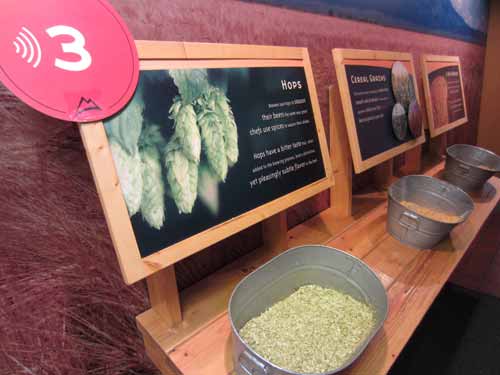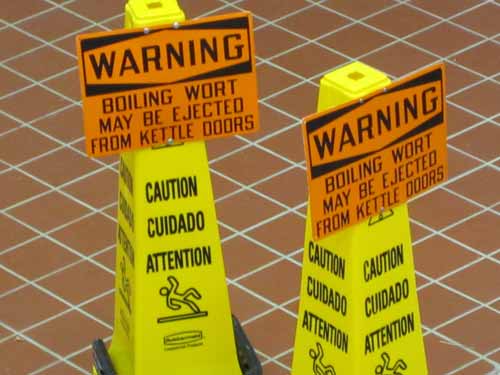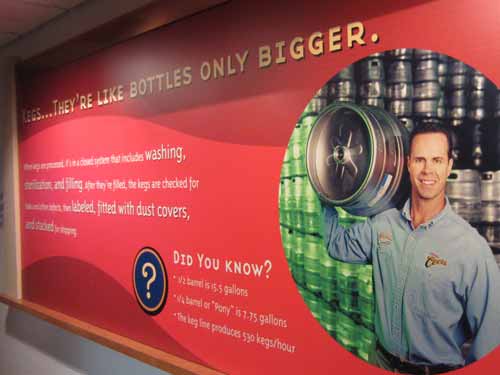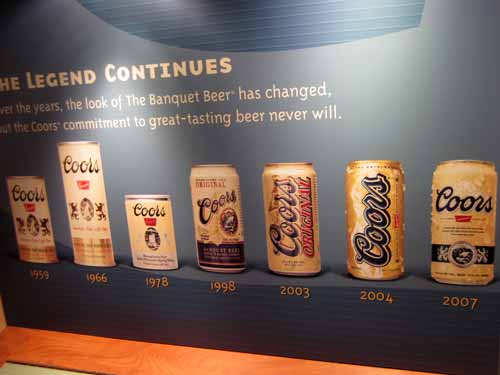
The line for the shuttle
After many shuttles came and went, eventually it was our time to board. The driver was quite entertaining and gave us a short tour around the downtown... even though the brewery was actually just across the street.

Boarding the beer bus

A drive through downtown

Yes, folks, the drinkng age is still, unbelievably, 21 years of age in the good ol' US of A.

This kettle was used in the late 1800's and early 1900's. It can hold 8,215 gallons (or 265 barrels).
Unlike my original tour, this one was self-guided with an audio tape. It was quite an extensive tour, with many exhibits and rooms... although most of the people rushed past in a hurry, in an apparent rush to get to the end of the tour (aka the three free beers).
Adolph Coors (born in 1847 in Prussia with the last name of "Kors") came to the States in 1868 from Germany. He was 21 and didn't have any money. He didn't even speak the language. But he did know how to make beer. He made his way West, working first as a laborer, then as a brewery foreman. He bought a bottling business in Denver and eventually started a brewery in 1873.


The horseless carriage

When alcoholic beverages were banned in Colorado in 1916, Coors switched to making malted milk for soda fountains and candy factories. Adolph Coors didn't live to see Prohibition repealed in 1933, but his son was able to return the brewery to its rightful production.

Some of the numerous brands
We made our way slowly through the many rooms filled with exhibits and down long hallways.

Lovely rooms and exhibits... which many people simply ran through.

The numbers corresponded to the audio tour.

Somehow I doubt that corn was an original ingredient. If Adolph Coors was indeed from Germany, he would have brewed according to the German tradition of the Reinheitsgebot (the beer purity law) which stated that the only ingredients allowed in the production of beer were water, barley and hops. They didn't know about yeast at the time they wrote it since beer was naturally fermented by wild yeast floating around in the air. This makes more sense when one realizes that most brewing was done in the town bakery... the only stone building in the village to help prevent fires.

Elaborate information kiosks, complete with videos

The videos took us from preparing the grains (including malting which is germinating and then drying)...

... through the mashing (steeping the grains in hot water... basically making grain tea) and boiling (cooking the resulting tea, now called wort, with the hops)...

... to filtering, cooling, fermenting and aging.

The different names of the malt (such as caramel or chocolate) come more from the color than any additives or taste.

Rows and rows of brew kettles

Some mash tuns

Now there's a sign you don't see every day... unless perhaps if you work here.

A peek into the Quality Control Lab with more scary signs

The fresh flowers honor Pete Coors’ mother (Pete is Adolph's great-grandson), who used to place them all around the brewery.
We then arrived at the Fresh Beer Room where we got a small sample. Unlike many other countries, the US serves its beer REALLY cold... as in frozen glasses and literally ice cold. To me, this merely accentuates the harsh carbonation and kills any flavor. But perhaps that is the point.

Fake ice cubes serve as shelves and chairs.


Hmmm... let's see... freezing temperature, harsh carbonation, no flavor, unpleasant aftertaste. This is definitely not like the beers I have enjoyed in Germany.
The tour continued past more informative signs and then the bottling lines. Along the way, tour guides were available for questions.

In 2003, Coors was the third largest producer of beer in the US. This brewery here in Golden is the largest single brewery facility in the world. In 2005, Coors merged with Molson (from Canada), and then with Miller in 2008.

As part of the old tour, we actually got to see where the train tracks came directly into the brewery packaging area.

The bottling, canning and kegging lines

"Kegs... They're like bottles only bigger." Uh... not quite. I mean, could you imagine grabbing a keg to put on the arm of your chair while watching a football game?

Coors invented the 2-piece aluminum can.
We finally arrived at the tasting room. The place was absolutely packed! We managed to eventually find a table and each got the first of our three allotted beers. Unfortunately, they were sooo much not to our tastes that we couldn't even finish them. Needless to say, we didn't bother trying any more.

One of the numerous ads of the past

Our list of tasting options

From left to right: alcohol free, Agave, and Killian's Red. While they certainly appeared beautiful, the looks were definitely deceiving.
We stopped briefly in the souvenir store. The sheer quantity of items was staggering... if you wanted something that said Coors on it, of course.

A penny for your thoughts

